The Mortuary Temple of Hatshepsut: A Guide to This Magnificent Ancient Structure
The Mortuary Temple of Hatshepsut is a mesmerizing masterpiece of ancient Egyptian architecture. Carved into the cliffs of Deir el-Bahri, this temple is unlike any other in Egypt, with its gargantuan dimensions measuring 280 metres in length and 25 metres in height. As the second female pharaoh of Egypt, Hatshepsut's reign and legacy are fascinating to explore. Whether you visit the temple alone or as part of a guided tour, this ancient structure is a must-see Egyptian landmark that offers a glimpse into the power and majesty of rulers in ancient Egypt.
In this concise guide, we will take you through the Mortuary Temple of Hatshepsut, delving into its history.
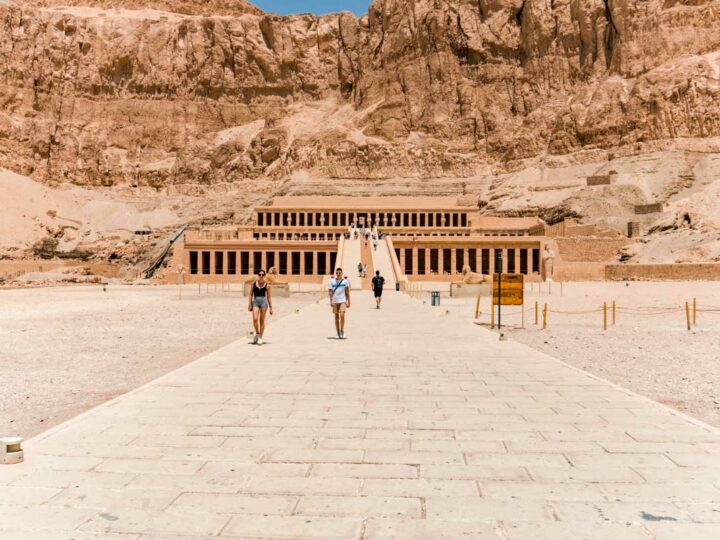
Overview of The Mortuary Temple of Hatshepsut
The Mortuary Temple of Hatshepsut, also known as Deir el-Bahari, is one of Egypt's most remarkable ancient structures. Built during the 15th century BC, this temple is located on the west bank of the Nile River, near the Valley of the Kings. It was constructed as a mortuary temple for Queen Hatshepsut, the second historically confirmed female Pharaoh of Egypt.
This magnificent temple played a significant role in ancient Egyptian history. It served as a place for religious rituals and ceremonies dedicated to the deities of ancient Egypt. It also acted as a memorial for Queen Hatshepsut and her achievements as a Pharaoh.
The design and layout of the temple are nothing short of breathtaking. It consists of three terraces, each rising above the other, with colonnades, statues, and intricate reliefs adorned throughout. The temple's location, nestled against the cliffs of the Theban mountains, adds to its grandeur and mystique.
Visitors can explore various levels and courtyards inside the temple, each offering unique architectural and artistic wonders. Notably, the collonaded hall of the temple stands out, with its impressive rows of statues and elaborate reliefs depicting scenes from Hatshepsut's reign.
Over the centuries, the temple has suffered damage and decay, partly due to natural causes and human interference. However, efforts to restore and preserve the temple have been undertaken to ensure its longevity and cultural significance.
To visit the Mortuary Temple of Hatshepsut, travellers can easily access it from Luxor by road or boat. Nearby attractions, such as the Valley of the Kings and the Colossi of Memnon, visit this remarkable temple a part of a broader exploration of ancient Egyptian history.
When planning a visit, it is advisable to dress modestly, wear comfortable shoes, and bring water, as the temple complex can be extensive to explore. Guided tours are available and recommended to appreciate the historical and architectural aspects of the temple fully.

Importance of the Temple in ancient Egyptian History
The Mortuary Temple of Hatshepsut holds great importance in ancient Egyptian history as it represents the remarkable achievements and contributions of Queen Hatshepsut, one of the few female pharaohs of ancient Egypt. The temple serves as a testament to her reign and exhibits the New Kingdom period's unique architectural style and grandeur.
Queen Hatshepsut assumed the throne during political uncertainty and successfully ruled for over two decades, establishing a stable and prosperous period in Egypt's history. Her contributions include expanding trade, undertaking ambitious building projects, and fostering the arts and religion. The mortuary temple, dedicated to the god Amun-Ra and the queen herself, showcases her power and accomplishments.
The design and layout of the temple are remarkable, featuring a monumental colonnade, terraced courtyards, and intricately carved reliefs depicting the queen's divine birth and achievements. The temple's location in the Valley of the Kings adds to its significance, as it served as a gateway to the afterlife and a place to worship pharaohs.
Visitors can explore the various levels and courtyards of the temple, marvelling at the impressive architecture and admiring the detailed reliefs that depict scenes from the queen's life and religious rituals. Notable features within the temple include the famous Hathor-headed columns, the birth colonnade, and the sanctuary dedicated to Amun-Ra.
Due to natural forces and human intervention over the centuries, the temple suffered damage and decay. However, ongoing restoration efforts have preserved its magnificence and allowed visitors to experience its historical and architectural splendour.
Visitors can take a guided tour or hire a taxi from Luxor to reach the temple. Nearby attractions, such as the Valley of the Kings and the Colossi of Memnon, provide an opportunity to explore the ancient wonders of Egypt further. When visiting the temple, it is advisable to wear comfortable clothing, bring sunscreen and water, and follow the guides' instructions for a smooth and enjoyable experience.
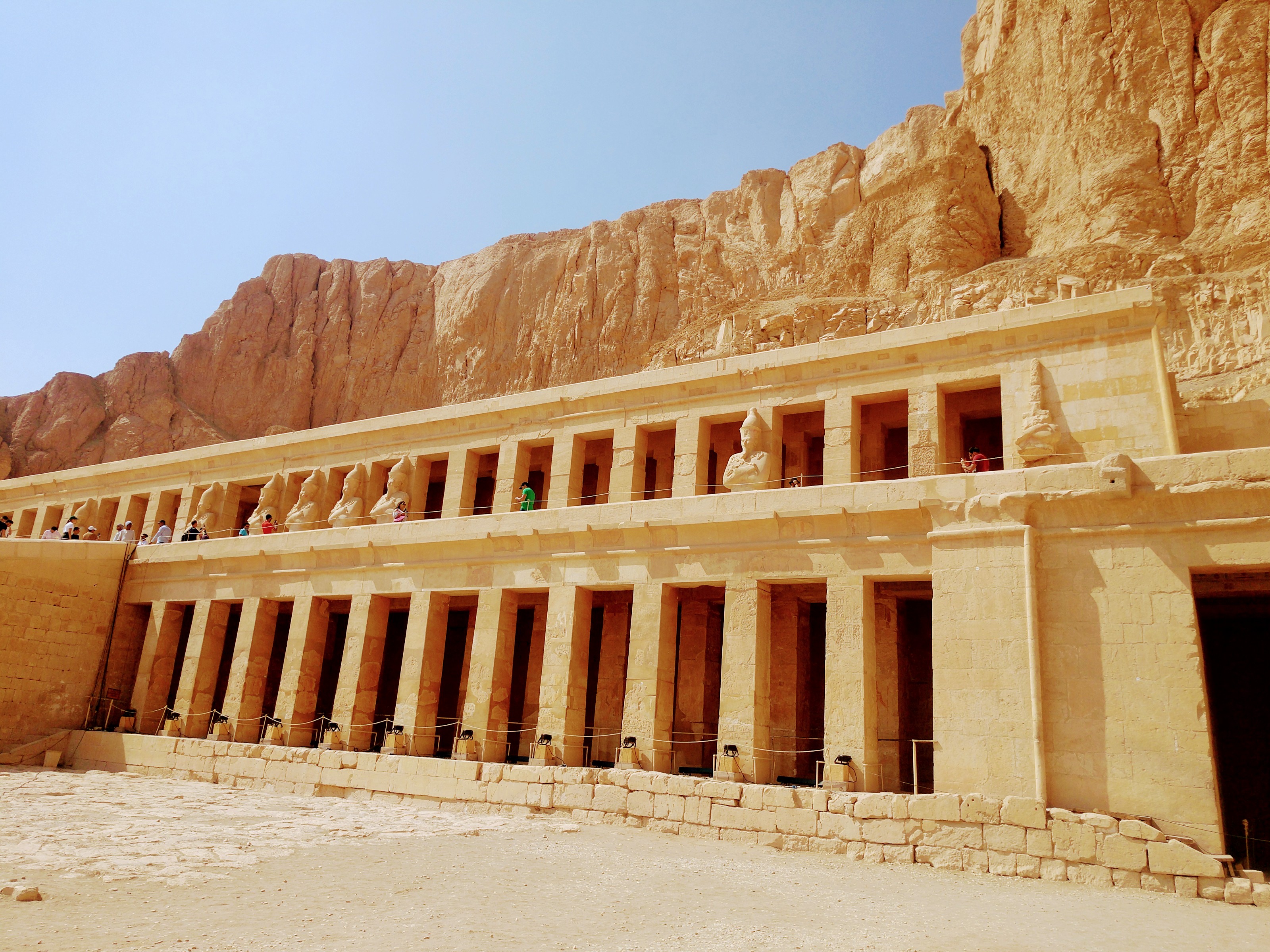
Queen Hatshepsut: A Brief Biography
Background and rise to power of Queen Hatshepsut
The Mortuary Temple of Hatshepsut is an ancient Egyptian structure with a fascinating history. To understand its significance, it's important to delve into the background and rise to power of Queen Hatshepsut.
Hatshepsut was the daughter of Pharaoh Thutmose I and Queen Ahmose. She became a powerful figure in ancient Egypt when she married her half-brother, Thutmose II, who inherited the throne. After Thutmose II's death, Hatshepsut became regent to her young stepson, Thutmose III, but eventually assumed the title of a pharaoh herself, becoming the first female pharaoh of Egypt.
Hatshepsut's reign was marked by numerous achievements and contributions to Egyptian society. She undertook ambitious building projects, including constructing her mortuary temple, which still stands today as a testament to her power and influence. Additionally, she revitalized trade routes and sponsored many expeditions to explore and expand Egyptian territories.
The design and layout of the Mortuary Temple of Hatshepsut reflect her desire to establish a lasting legacy. The temple features a series of terraces and colonnades, blending seamlessly into the natural rock formations of the surrounding area. The depiction of Hatshepsut as a male pharaoh in many of the temple's reliefs and statues further highlights her unprecedented role in ancient Egyptian history.
Visiting the Mortuary Temple of Hatshepsut provides a unique opportunity to witness this remarkable queen's achievements and artistic grandeur. The temple's location in the Valley of the Kings adds to its allure, as it was strategically situated to honour Hatshepsut and ensure her immortality. Whether you're an ancient history enthusiast or simply curious about one of Egypt's most iconic structures, exploring the Mortuary Temple of Hatshepsut is an experience not to be missed.

Achievements and contributions as Pharaoh
As Pharaoh, Queen Hatshepsut made significant achievements and contributions that left a lasting impact on ancient Egyptian history:
-
Economic Prosperity: Hatshepsut's reign was marked by increased trade and economic prosperity. She sent expeditions to the Land of Punt, a region identified with present-day Somalia, bringing back valuable resources such as gold, ivory, and exotic animals.
-
Architectural Marvels: Hatshepsut commissioned several impressive architectural projects, including constructing her mortuary temple. She also oversaw the restoration and expansion of existing temples, demonstrating her commitment to the gods and the preservation of Egypt's religious institutions.
-
Art and Culture: Hatshepsut was a great art patron and promoted a flourishing cultural scene during her reign. Artists and craftsmen created exquisite statues and reliefs that depicted Hatshepsut in traditional male pharaonic regalia, showcasing her authority and power.
-
Political Stability: Under Hatshepsut's rule, Egypt enjoyed a period of relative political stability and peace. She maintained diplomatic relations with neighbouring kingdoms and focused on consolidating her power within Egypt, ensuring smooth governance and continuity.
These achievements demonstrate Hatshepsut's ability to rule effectively and her dedication to promoting Egypt's prosperity and cultural heritage.
Architectural Features of the Temple
Description of the temple's design and layout
The Mortuary Temple of Hatshepsut, also known as Deir el-Bahri, is a remarkable ancient structure located on the west bank of the Nile River near Luxor, Egypt. Designed by the architect Senenmut, the temple exemplifies the classical architecture of the New Kingdom period. Its unique design and layout contribute to its grandeur and historical significance.
The temple is built on several terraces connected by ramps and staircases. The lower terrace features colonnades with large papyrus-shaped pillars, giving the temple an elegant and regal appearance. The middle terrace includes a central courtyard with statues of the queen and various deities. This area also houses a sanctuary dedicated to the god Amun.
One of the temple's most striking features is the upper terrace, which is dominated by a large portico with columns and a porticoed court. This terrace was dedicated to the sun god Re-Horakhty and showcased exquisite reliefs depicting scenes from Queen Hatshepsut's reign and her religious rituals.
The design of the temple integrates harmoniously with the natural landscape. The temple is set against the dramatic backdrop of the sheer cliff known as the "Thebes Mountain," providing a picturesque setting for visitors. The temple's orientation towards the east, facing the rising sun, symbolized the rebirth of Hatshepsut as a divine ruler and affirmed her legitimacy as the pharaoh.
Visitors to the temple can explore its various levels and courtyards, wandering through the intricate colonnades and admiring the detailed reliefs and wall decorations. Notable temple features include the famous Osiride statues, the chapels dedicated to various gods, and the well-preserved depictions of Queen Hatshepsut's achievements.
The Mortuary Temple of Hatshepsut has undergone significant restoration and preservation efforts, ensuring its protection for future generations. Today, it remains one of the most visited and awe-inspiring ancient Egyptian monuments, offering a glimpse into the history and grandeur of a remarkable ruler and era.
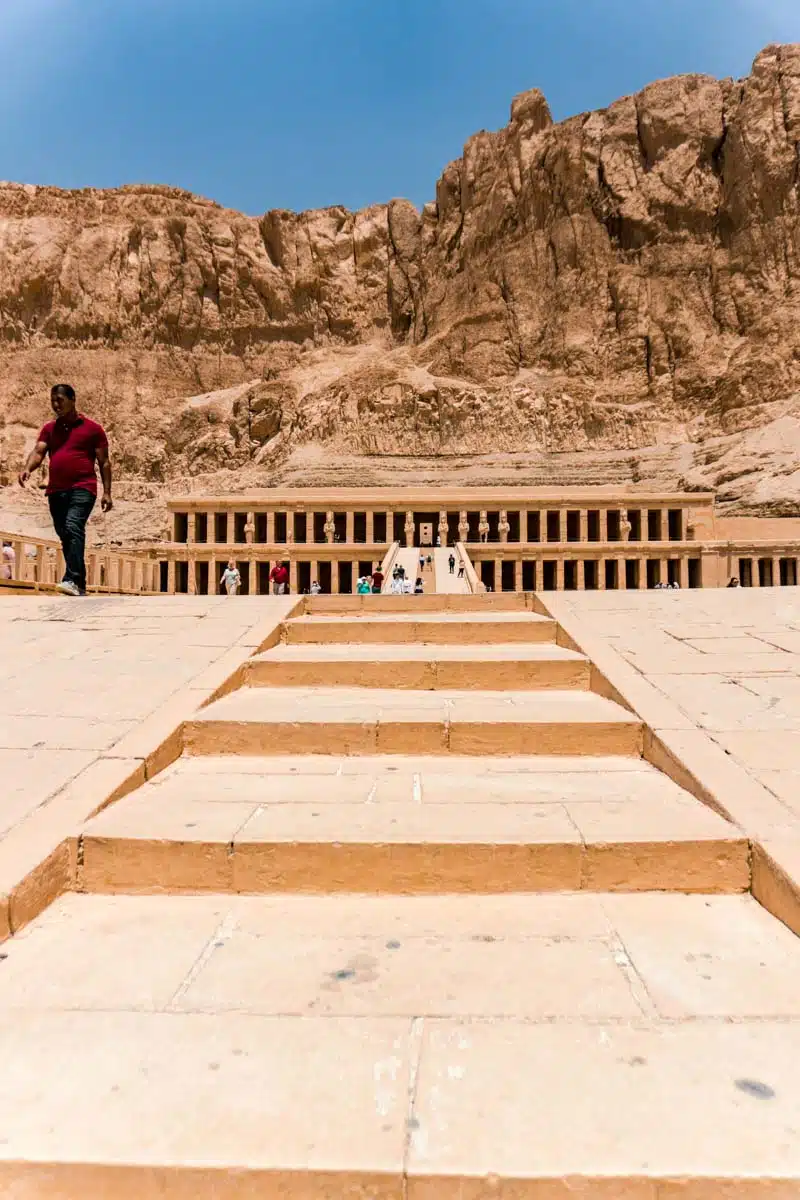
Significance of the temple's location and orientation
The Mortuary Temple of Hatshepsut is located on the west bank of the Nile River in Luxor, Egypt. Its strategic location was chosen for symbolic and practical reasons, making it a significant structure in ancient Egyptian history.
The orientation of the temple plays a crucial role in its significance. The temple was constructed in a valley at the foot of limestone cliffs to align it with the sun's path. This alignment was symbolic of the journey of the sun god Ra, who was believed to travel across the sky during the day and descend into the underworld at night. By aligning the temple with the sun's path, it was believed that Ra would guide Hatshepsut's soul on her journey through the afterlife.
Furthermore, the temple's location was strategically chosen to establish Hatshepsut's connection with the gods and enhance the divine nature of her reign. The cliffs surrounding the temple were seen as a natural extension of the divine realm, while the flat, open space in front of the temple represented the mundane world. This juxtaposition symbolizes the connection between the mortal and divine realms, with Hatshepsut as a bridge between the two.
The orientation and location of the Mortuary Temple of Hatshepsut, along with its unique architectural design and artistic features, make it a remarkable example of ancient Egyptian temple construction and an important testament to the power and legacy of Queen Hatshepsut.
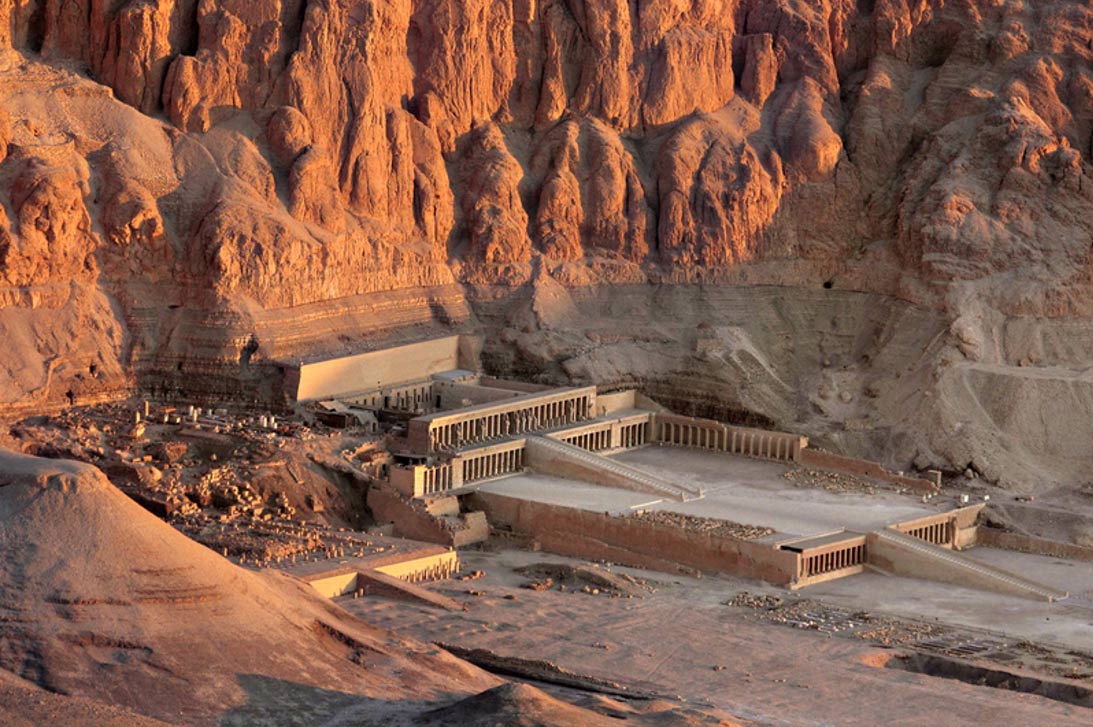
Exploration Inside the Temple
Touring the various levels and courtyards of the temple
Visitors can explore its various levels and courtyards when visiting the Mortuary Temple of Hatshepsut. The temple is designed in a terraced manner, with three main levels connected by ramps and stairways.
- The first level is the grand entrance, consisting of large, open courtyards. Here, visitors can admire the impressive colonnades and statues that line the pathway leading up to the temple. The statues depict Queen Hatshepsut in various poses, providing insight into her power and authority.
- The second level is the heart of the temple and includes the main sanctuary and chapels dedicated to the gods. This level is adorned with intricate reliefs and carvings that depict important events and religious rituals. Visitors can also explore the hypostyle hall, which features massive pillars and a beautifully decorated ceiling.
- The third level is the temple's highest point and offers breathtaking views of the surrounding landscape. Here, visitors can appreciate the architectural mastery of the temple and soak in the rich history and spirituality of the site.
During the tour, it is recommended to take your time and fully immerse yourself in the beauty and significance of each level. Don't forget to bring a camera to capture the temple's stunning views and intricate details.
Overall, touring the various levels and courtyards of the Mortuary Temple of Hatshepsut provides a unique opportunity to delve into the ancient Egyptian civilisation and witness the grandeur and majesty of one of its most remarkable structures.

Notable features and artworks within the temple
The Mortuary Temple of Hatshepsut is an architectural marvel and houses several notable features and artworks that offer a glimpse into ancient Egyptian culture and artistry. Here are some of the highlights found within the temple:
-
Collonaded Terraces: The temple is famous for its three impressive collonaded terraces, each featuring rows of graceful pillars. These colonnades were adorned with exquisite reliefs depicting scenes from Hatshepsut's reign and religious rituals.
-
Statue of Hatshepsut: A prominent feature of the temple is the large seated statue of Hatshepsut, depicting her in traditional pharaonic attire. This statue is a testament to her power and authority as the first female pharaoh of ancient Egypt.
-
Chapels and Sanctuaries: The temple complex contains several small chapels and sanctuaries dedicated to various Egyptian deities, such as Amun-Ra. These sacred spaces were used for worship and religious ceremonies.
-
Obelisks: Two towering obelisks once adorned the temple's entrance, symbolizing the connection between the mortal world and the divine. Although one of the obelisks is now located in the Metropolitan Museum of Art in New York City, the remaining obelisk is a remarkable testament to ancient Egyptian engineering.
-
Hieroglyphic Inscriptions: Throughout the temple, visitors can find numerous hieroglyphic inscriptions and reliefs that depict scenes from Hatshepsut's life and military campaigns. These inscriptions provide valuable insight into the queen's achievements and reign.
Exploring these remarkable features and artworks within the Mortuary Temple of Hatshepsut offers a unique opportunity to delve into the rich history of ancient Egypt and appreciate its people's craftsmanship and artistic skills.
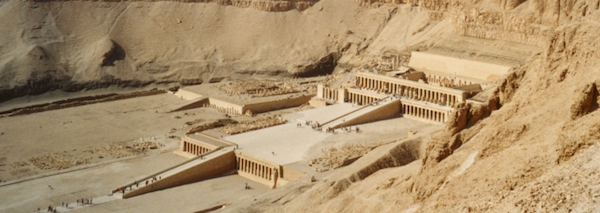
Restoration and Conservation Efforts
History of damage and decay suffered by the temple
Like many ancient structures, the Mortuary Temple of Hatshepsut has endured its fair share of damage and decay over the centuries. One significant event that impacted the temple's preservation was the intentional destruction carried out by Thutmose III, Hatshepsut's stepson and successor, who sought to erase her memory and legacy. This act removed her images and inscriptions from the temple walls, leaving behind blank spaces that later scholars had to decipher and reconstruct.
Furthermore, natural forces such as erosion, floods, and earthquakes have also contributed to the deterioration of the temple over time. The temple's location, situated at the base of cliffs, makes it vulnerable to the harsh desert winds and sandstorms that gradually wear down the delicate details of the structure.
In recent years, efforts have been made to restore and preserve the temple. The Egyptian Ministry of Antiquities, in collaboration with international organizations and experts, have undertaken extensive conservation work to stabilize the temple's remaining structures and protect them from further damage. This includes repairing damaged walls, reinforcing foundations, and implementing measures to prevent erosion.
Visitors to the temple today can witness the results of these restoration efforts and ongoing conservation work. It is a testament to the determination and dedication of archaeologists and preservationists to ensure that the temple of Hatshepsut continues to inspire awe and wonder for future generations.
To best experience the temple and its history, here are some important tips:
- Wear comfortable shoes, as there is a fair amount of walking involved.
- Bring sunscreen and a hat, as the sun exposes the temple.
- Consider hiring a local guide who can provide insights and stories about the temple's significance.
- Visit early in the morning or late in the afternoon to avoid the crowds and intense heat.
- Make sure to explore all the levels and courtyards of the temple to appreciate its architectural grandeur and artistic details fully.
- Take the time to admire the various reliefs and statues within the temple, which depict scenes from Hatshepsut's life and religious rituals.
- Combine your visit to the temple with other nearby attractions, such as the Valley of the Kings and the Colossi of Memnon, for a comprehensive experience of ancient Egyptian history.
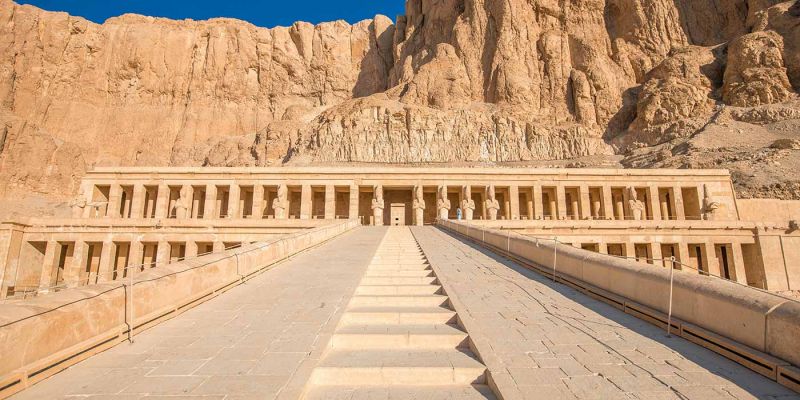
Efforts to restore and preserve the temple for future generations
The Mortuary Temple of Hatshepsut has faced various challenges over the centuries, including extensive damage and decay. However, there have been significant efforts to restore and preserve this magnificent ancient structure for future generations to admire and appreciate.
Since its rediscovery in the early 19th century, the temple has undergone multiple restoration campaigns, with the most extensive in the 20th century. During these restoration efforts, damaged and missing sections were reconstructed, and weathered reliefs were carefully conserved to protect the intricate artwork.
One of the notable restoration projects was led by French Egyptologist Jean-François Champollion in the 19th century. He worked on stabilizing the structure and reconstructing the fallen colonnades, restoring the temple to its former grandeur.
In recent years, the Egyptian government and various international organizations have collaborated on further restoration and preservation projects. These efforts aim to strengthen the temple's infrastructure, protect the fragile reliefs, and improve visitor facilities.
Conservation measures include the installation of protective barriers, documentation and analysis of the temple's condition, and ongoing research to develop innovative preservation techniques.
Visitors can now enjoy a more complete and well-preserved Mortuary Temple of Hatshepsut, thanks to the dedicated efforts of archaeologists, architects, and conservators who recognize its historical and cultural significance.
Visiting the Temple: Practical Information
How to get to the temple and nearby attractions
To reach The Mortuary Temple of Hatshepsut, visitors can follow a few different routes, depending on their starting point:
-
From Luxor: The temple is located on the west bank of the Nile River, near the Valley of the Kings. Tourists can hire a taxi from Luxor or take a guided tour of the temple. The journey takes approximately 30 minutes by car.
-
From the Valley of the Kings: If you visit the Valley of the Kings, the temple is just a short distance away. Visitors can walk or take a shuttle bus to the temple. The walk is relatively easy and offers beautiful views of the surrounding landscape.
-
From Aswan: If you are staying in Aswan, visiting the temple on a day trip is possible. Many travel agencies in Aswan offer guided tours that include transportation to the temple, usually by air-conditioned minivan or coach. The journey from Aswan to the temple takes approximately 3-4 hours.
Nearby attractions include the Valley of the Kings, where tourists can explore the elaborate tombs of ancient Egyptian pharaohs. The Valley of the Queens is also located nearby and is home to the tombs of several queens and princesses. Additionally, the Colossi of Memnon, two massive stone statues of Pharaoh Amenhotep III, are a popular stop for tourists visiting the temple.
Here are some tips to ensure a smooth and enjoyable visit:
- It is best to visit the temple early in the morning or late in the afternoon to avoid the crowds and the day's heat.
- Wear comfortable shoes, as there is quite a bit of walking involved, especially if you want to explore the different levels and courtyards of the temple.
- Bring sunscreen, a hat, and plenty of water, as the temple is in a desert area and can get extremely hot.
- Consider hiring a local guide to provide insights and historical context during your visit.
- Respect the rules and regulations of the site, such as not touching or climbing on the ancient structures.
- Take your time to appreciate the intricate carvings and hieroglyphics on the temple walls, depicting the fascinating story of Queen Hatshepsut's reign and achievements.
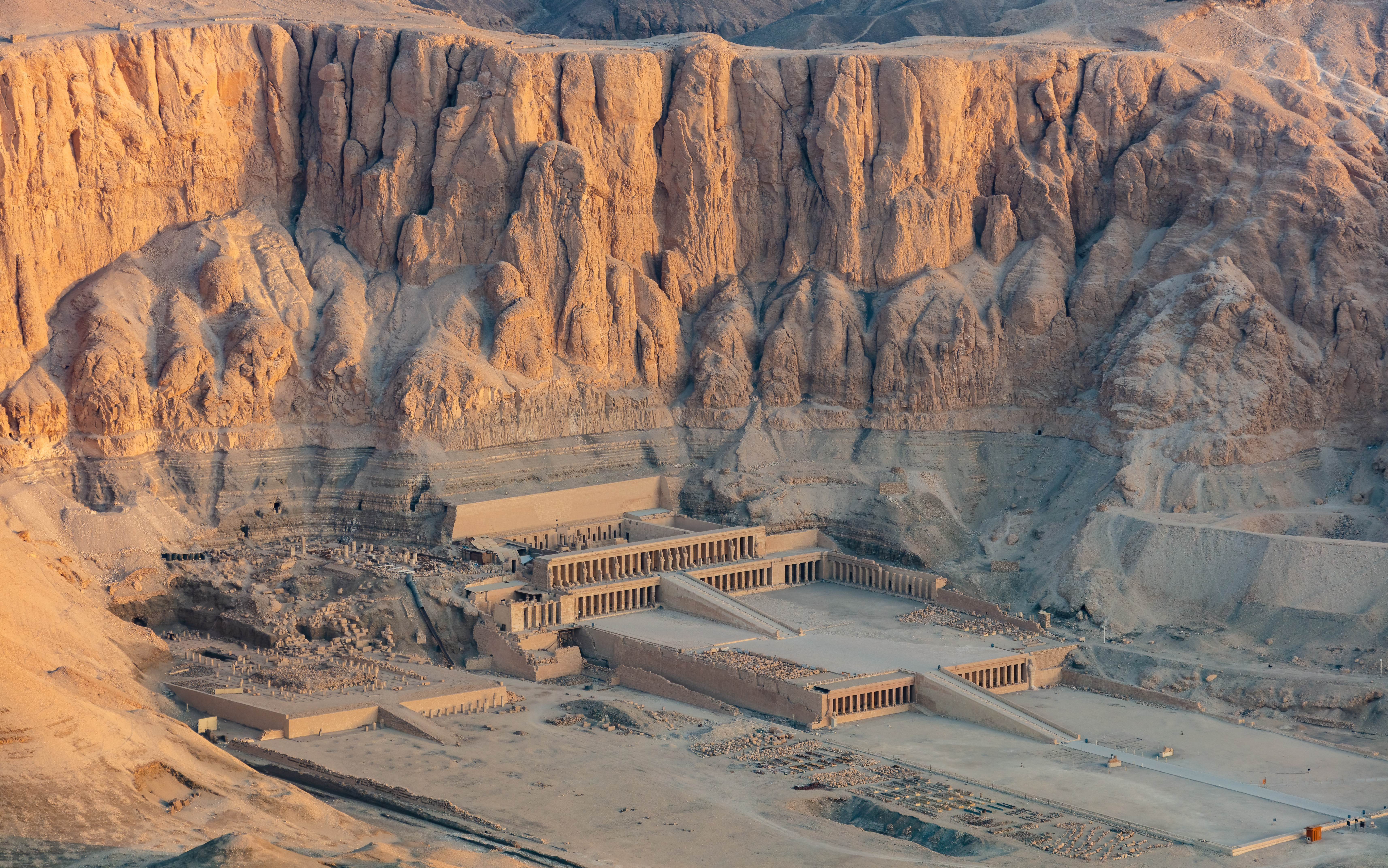
Tips for a smooth and enjoyable visit
When visiting the Mortuary Temple of Hatshepsut, there are a few tips to ensure a smooth and enjoyable experience:
-
Arrive Early: To beat the crowds and make the most of your visit, arriving at the temple early in the morning when it opens is advisable. This will give you ample time to explore the various levels and courtyards without feeling rushed.
-
Stay Hydrated: The temple complex can get quite hot, especially during the summer, so remember to bring a water bottle to stay hydrated. No vendors or facilities sell refreshments within the temple, so it is best to come prepared.
-
Dress Appropriately: As the Mortuary Temple of Hatshepsut is a religious site, it is important to dress modestly and respectfully. Wear clothing that covers your shoulders and knees to show respect for the ancient Egyptian culture.
-
Wear Comfortable Shoes: The temple complex is spread out over multiple levels and involves a fair amount of walking, so it is essential to wear comfortable shoes. Additionally, some areas of the temple have uneven surfaces, so sturdy footwear is recommended.
-
Bring Sun Protection: Due to the open-air nature of the temple, it is important to protect yourself from the sun. Bring a hat, sunglasses, and sunscreen to shield yourself from the harsh rays.
-
Follow the Rules: Respect any signage, barriers, or instructions given by the temple staff to ensure the preservation and safety of the site. This includes not touching or climbing on any of the ancient structures or artefacts.
With these tips in mind, you can make the most of your visit to the Mortuary Temple of Hatshepsut and fully immerse yourself in its magnificent ancient history.
